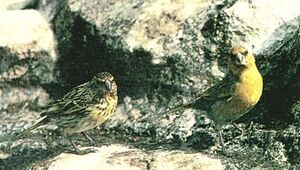Nihoa finch facts for kids
Quick facts for kids Nihoa finch |
|
|---|---|
 |
|
| Male (right) and female (left) pair of Nihoa finches | |
| Conservation status | |
| Scientific classification | |
| Genus: |
Telespiza
|
| Species: |
ultima
|
The Nihoa finch (Telespiza ultima) is a special little bird that lives only on the tiny Hawaiian island of Nihoa. It's one of just two bird species found nowhere else in the world, besides the Nihoa millerbird, that call this island home.
Scientists estimate there are about 1,000 to 3,000 of these birds living on Nihoa. Because there are so few, the Nihoa finch was put on the Endangered Species List in 1967. This means it needs special protection to survive. Efforts were made to help the species, like trying to start a new group of finches on another island, French Frigate Shoals. However, this attempt didn't work out.
Nihoa Island is part of the Hawaiian Islands National Wildlife Refuge. This protected area helps keep the Nihoa finch safe in its natural home.
What Does the Nihoa Finch Look Like?
The Nihoa finch is a small bird, about 6 inches long. It looks a lot like another bird called the Laysan finch, but it's a bit smaller and its colors are not as dark.
These finches have a bright yellow throat. Their front feathers are streaked with brown. The top of their head and their back are brown with black streaks.
What Do Nihoa Finches Eat?
The Nihoa finch has a varied diet. They enjoy eating the eggs of other seabirds. They also look for small arthropods, which are like tiny insects or spiders.
Besides animal food, they also eat plants. They like the seeds and flowers from some of the native plants that grow on Nihoa Island.
Life Cycle and Nesting
Nihoa finches are very clever about where they build their nests. They choose small, safe spots in the rocky cliffs of the island. These nests can be found anywhere from about 100 to 800 feet above the sea level.
Their breeding season usually starts in February and can last until early July. During this time, the female finch typically lays a clutch of three eggs. It takes about one year for a young Nihoa finch to grow and get its full adult plumage, which means its adult feathers.


